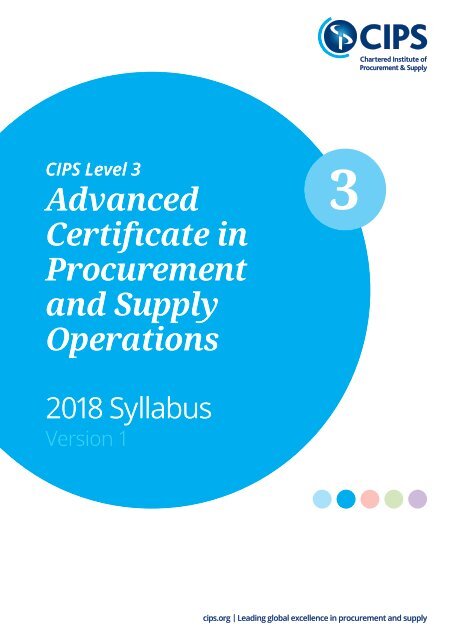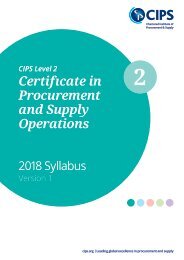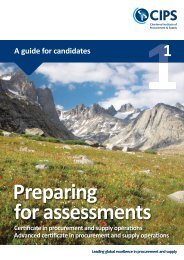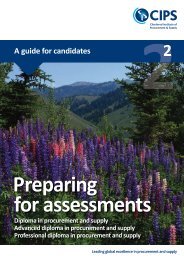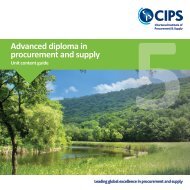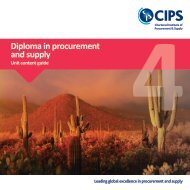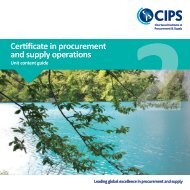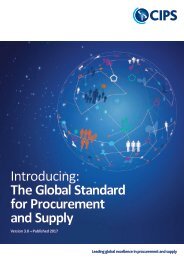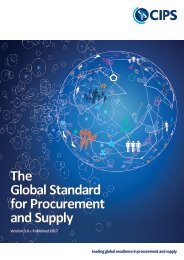CIPS Level 3 Certificate in Procurement and Supply Operations 2018 Syllabus
Create successful ePaper yourself
Turn your PDF publications into a flip-book with our unique Google optimized e-Paper software.
<strong>CIPS</strong> <strong>Level</strong> 3<br />
Advanced<br />
Certifıcate <strong>in</strong><br />
<strong>Procurement</strong><br />
<strong>and</strong> <strong>Supply</strong><br />
<strong>Operations</strong><br />
3<br />
<strong>2018</strong> <strong>Syllabus</strong><br />
Version 1
Your<br />
qualifıcation<br />
The Chartered Institute of <strong>Procurement</strong> & <strong>Supply</strong> (<strong>CIPS</strong>) qualifications are recognised by education<br />
regulators from various countries. Our <strong>Level</strong> 3* Advanced <strong>Certificate</strong> <strong>in</strong> <strong>Procurement</strong> <strong>and</strong><br />
<strong>Operations</strong> is a vocationally related professional qualification. <strong>CIPS</strong> is an Ofqual (Engl<strong>and</strong>), CCEA<br />
Regulation (Northern Irel<strong>and</strong>) <strong>and</strong> Qualifications Wales, regulated qualifications award<strong>in</strong>g<br />
organisation. The <strong>CIPS</strong> qualifications are listed on the Regulated Qualifications Framework (RQF).<br />
<strong>CIPS</strong> members will be able to have the confidence <strong>in</strong> our regulated qualifications, which reliably<br />
<strong>in</strong>dicate the knowledge, skills <strong>and</strong> underst<strong>and</strong><strong>in</strong>g that a learner is required to demonstrate.<br />
This is an entry level vocationally related qualification it Developed <strong>in</strong> close collaboration with experts from the<br />
is designed to follow on from the <strong>CIPS</strong> <strong>Level</strong> 2 <strong>Certificate</strong> procurement <strong>and</strong> supply profession <strong>and</strong> bus<strong>in</strong>esses, <strong>and</strong><br />
<strong>in</strong> <strong>Procurement</strong> <strong>and</strong> <strong>Supply</strong> <strong>Operations</strong> as learners are with the providers who will be deliver<strong>in</strong>g the qualifications,<br />
expected to develop, use <strong>and</strong> apply the professional <strong>CIPS</strong> <strong>Level</strong> 3 Advanced <strong>Certificate</strong> <strong>in</strong> <strong>Procurement</strong> <strong>and</strong> <strong>Supply</strong><br />
language <strong>and</strong> skill sets <strong>in</strong>troduced at <strong>Level</strong> 2 with<strong>in</strong> a <strong>Operations</strong> is designed for <strong>in</strong>dividuals who will be work<strong>in</strong>g<br />
practical work<strong>in</strong>g environment. This qualification will at the Tactical but mov<strong>in</strong>g towards the Operational level of<br />
prepare <strong>in</strong>termediate level learners look<strong>in</strong>g to specialise the <strong>CIPS</strong> Global St<strong>and</strong>ard for <strong>Procurement</strong> <strong>and</strong> <strong>Supply</strong>. This<br />
<strong>in</strong> procurement <strong>and</strong> supply <strong>and</strong> to progress onto the <strong>CIPS</strong> is the first level of the <strong>CIPS</strong> qualifications structure where<br />
<strong>Level</strong> 4 Diploma <strong>in</strong> <strong>Procurement</strong> <strong>and</strong> <strong>Supply</strong>.<br />
elective modules are <strong>in</strong>troduced, giv<strong>in</strong>g learners the choice of<br />
a specific professional path such as <strong>Procurement</strong> or <strong>Supply</strong><br />
Entry level Entry level Highest Cha<strong>in</strong>. Entry level<br />
<strong>Level</strong> 2<br />
<strong>Certificate</strong> <strong>in</strong><br />
<strong>Procurement</strong><br />
<strong>and</strong> <strong>Supply</strong><br />
<strong>Operations</strong><br />
<strong>Level</strong> 3<br />
Advanced<br />
<strong>Certificate</strong> <strong>in</strong><br />
<strong>Procurement</strong><br />
<strong>and</strong> <strong>Supply</strong><br />
<strong>Operations</strong><br />
<strong>Level</strong> 4<br />
Diploma <strong>in</strong><br />
<strong>Procurement</strong><br />
<strong>and</strong><br />
<strong>Supply</strong><br />
<strong>Level</strong> 5<br />
Advanced<br />
Diploma <strong>in</strong><br />
<strong>Procurement</strong><br />
<strong>and</strong> <strong>Supply</strong><br />
<strong>Level</strong> 6<br />
Professional<br />
Diploma <strong>in</strong><br />
<strong>Procurement</strong><br />
<strong>and</strong> <strong>Supply</strong><br />
Next steps<br />
This qualification provides progression to the <strong>CIPS</strong> <strong>Level</strong> 4 Diploma <strong>in</strong><br />
<strong>Procurement</strong> <strong>and</strong> <strong>Supply</strong>.<br />
<strong>Level</strong> 4<br />
* Refers to levels with<strong>in</strong> the RQF. Other regulatory bodies may have different correspond<strong>in</strong>g levels<br />
We have created a suite of regulated, flexible <strong>and</strong> agile professional<br />
qualifications that pave the way for a whole new generation of global<br />
procurement <strong>and</strong> supply learners.<br />
Dr Gary Ramsden, F<strong>CIPS</strong> Chartered Professional, Head of Education Development <strong>and</strong> St<strong>and</strong>ards, <strong>CIPS</strong><br />
Based on the Tactical <strong>and</strong> Operational competency levels of <strong>CIPS</strong> Global St<strong>and</strong>ard<br />
cips.org/qualifications
Guide to qualification content<br />
Four CORE MANDATORY modules make up 24 of the required credits<br />
30<br />
Credits<br />
required for<br />
completion<br />
CORE <strong>Level</strong> 3 <strong>Procurement</strong><br />
<strong>and</strong> <strong>Supply</strong> Environments<br />
(L3M1)<br />
6<br />
CREDITS<br />
CORE <strong>Level</strong> 3 Contract<br />
Adm<strong>in</strong>istration (L3M3) 6<br />
CREDITS<br />
CORE <strong>Level</strong> 3 Ethical<br />
<strong>Procurement</strong> <strong>and</strong> <strong>Supply</strong><br />
(L3M2)<br />
6<br />
CREDITS<br />
CORE <strong>Level</strong> 3 Team<br />
Dynamics <strong>and</strong> Change (L3M4) 6<br />
CREDITS<br />
24<br />
Credits made<br />
up of CORE<br />
MANDATORY<br />
modules<br />
Choose one ELECTIVE module to make up the f<strong>in</strong>al six required credits<br />
ELECTIVE <strong>Level</strong> 3 Socially<br />
Responsible <strong>Procurement</strong><br />
(L3M5)<br />
6<br />
CREDITS<br />
ELECTIVE <strong>Level</strong> 3 Socially<br />
Responsible Warehous<strong>in</strong>g<br />
<strong>and</strong> Distribution (L3M6)<br />
6<br />
CREDITS<br />
6<br />
Credits made up<br />
of your choice of<br />
ELECTIVE<br />
module<br />
Who is it for?<br />
This qualification will prepare <strong>in</strong>termediate level learners look<strong>in</strong>g to specialise <strong>in</strong> procurement <strong>and</strong> supply <strong>and</strong><br />
to progress onto the <strong>CIPS</strong> <strong>Level</strong> 4 Diploma <strong>in</strong> <strong>Procurement</strong> <strong>and</strong> <strong>Supply</strong>.<br />
What will I learn?<br />
Learn how to apply factual, procedural <strong>and</strong> theoretical knowledge of procurement <strong>and</strong> supply. You will be able<br />
to completes tasks <strong>and</strong> address problems that are well-def<strong>in</strong>ed but may be complex <strong>and</strong> non-rout<strong>in</strong>e. You will<br />
underst<strong>and</strong> what relevant <strong>in</strong>formation is required <strong>and</strong> how to <strong>in</strong>terpret <strong>and</strong> review its effectiveness.<br />
Entry requirements<br />
This is the second entry level qualification, there are no formal entry requirements.<br />
Total credits required for completion<br />
30<br />
03
How<br />
long will<br />
I study for?<br />
Your total qualification time (TQT)<br />
The TQT <strong>in</strong>dicates the overall number of guided learn<strong>in</strong>g hours, additional<br />
self-study <strong>and</strong> assessment time that is required.<br />
300<br />
TQT HRS<br />
Guided learn<strong>in</strong>g hours (GLH)<br />
It is expected that you will undertake 200 GLH. The def<strong>in</strong>ition of guided<br />
learn<strong>in</strong>g hours is: ‘A measure of the amount of <strong>in</strong>put time required to<br />
achieve the qualification. This <strong>in</strong>cludes lectures, tutorials <strong>and</strong> practicals,<br />
as well as supervised study <strong>in</strong>, for example, learn<strong>in</strong>g centres <strong>and</strong><br />
workshops’.<br />
Self-study requirement (SSR)<br />
Additionally, we recommend that you also commit to at least [90 SSR]<br />
hours. This <strong>in</strong>cludes wider read<strong>in</strong>g of the subject areas <strong>and</strong> revision to give<br />
yourself the best preparation for successfully achiev<strong>in</strong>g the qualification.<br />
Total exam time<br />
All the modules <strong>in</strong> <strong>CIPS</strong> qualifications are assessed by an exam<strong>in</strong>ation.<br />
200<br />
GLH HRS<br />
90<br />
SSR HRS<br />
10<br />
HRS<br />
cips.org/qualifications
C<br />
CORE MODULE<br />
<strong>CIPS</strong> GLOBAL<br />
STANDARD<br />
2.1 • 2.2 • 4.4 • 11.2<br />
<strong>Procurement</strong><br />
<strong>and</strong> <strong>Supply</strong><br />
Environments<br />
[L3M1]<br />
Module purpose<br />
2HRS<br />
EXAM DURATION<br />
HOURS<br />
60<br />
HRS<br />
TOTAL QUALIFICATION<br />
TIME (TQT)<br />
On completion of this module, learners will be able to identify the range of environments<br />
<strong>in</strong> which procurement <strong>and</strong> supply is expected to operate <strong>and</strong> the external factors that can<br />
impact on overall success.<br />
Module aim(s)<br />
<strong>Procurement</strong> <strong>and</strong> supply is to operate <strong>in</strong> a varied range of environments. As well as the<br />
public <strong>and</strong> private sectors, those responsible for the procurement <strong>and</strong> supply function may<br />
f<strong>in</strong>d themselves work<strong>in</strong>g with those <strong>in</strong> not-for-profit organisations. This module is designed<br />
for those who are <strong>in</strong>volved <strong>in</strong> the procurement <strong>and</strong> supply function, who must recognise the<br />
wider environment <strong>in</strong> which they work <strong>and</strong> the impacts that different types of organisations<br />
can have on successfully meet<strong>in</strong>g with overall organisational needs. They must know the<br />
importance of the external environment <strong>and</strong> also identify the procedures that regulate<br />
procurement <strong>and</strong> supply.<br />
6<br />
Credit value<br />
05
Learn<strong>in</strong>g outcomes, assessment criteria <strong>and</strong> <strong>in</strong>dicative content<br />
1.0 Know the different sectors of procurement <strong>and</strong> supply<br />
1.1 Def<strong>in</strong>e the different types <strong>and</strong> functions of the private<br />
sector<br />
• Def<strong>in</strong>itions <strong>and</strong> different types of private sector<br />
organisations – sole traders, partnerships, registered<br />
companies, <strong>in</strong>corporated <strong>and</strong> un<strong>in</strong>corporated<br />
companies, SME, mult<strong>in</strong>ational corporations<br />
• The size <strong>and</strong> scope of the private sector <strong>in</strong> different<br />
economies<br />
• Functions of private sector organisations such<br />
as profit, growth, market share, share price,<br />
other f<strong>in</strong>ancial measures, corporate <strong>and</strong> social<br />
responsibility<br />
1.2 Describe the role <strong>and</strong> scope of procurement <strong>and</strong><br />
supply <strong>in</strong> the private sector<br />
• Sole trade, partnerships, registered companies,<br />
<strong>in</strong>corporated <strong>and</strong> un<strong>in</strong>corporated companies<br />
• Small <strong>and</strong> medium sized organisations (SMEs)<br />
• Mult<strong>in</strong>ational organisations<br />
• The roles of procurement <strong>and</strong> supply <strong>in</strong> the private<br />
sector<br />
1.3 Describe the role <strong>and</strong> scope of procurement <strong>and</strong><br />
supply <strong>in</strong> the public sector<br />
• Def<strong>in</strong><strong>in</strong>g the public sector<br />
• Central <strong>and</strong> local government<br />
• The functions of public sector organisations<br />
• The roles of procurement <strong>and</strong> supply <strong>in</strong> the public<br />
sector<br />
• Commission<strong>in</strong>g <strong>and</strong> procurement<br />
• Achiev<strong>in</strong>g budget sav<strong>in</strong>gs <strong>and</strong> other sources of added<br />
value<br />
• Provid<strong>in</strong>g access to services<br />
• Regulat<strong>in</strong>g organisations <strong>and</strong> <strong>in</strong>dividuals<br />
1.4 Describe the role <strong>and</strong> scope of procurement <strong>and</strong><br />
supply <strong>in</strong> the not-for-profit <strong>and</strong> third sector<br />
• Def<strong>in</strong><strong>in</strong>g the not-for-profit <strong>and</strong> third sector<br />
• Public accountability for the not-for-profit <strong>and</strong> third<br />
sector<br />
• Def<strong>in</strong>e the role of procurement <strong>and</strong> supply <strong>in</strong> the<br />
not-for-profit <strong>and</strong> third sector<br />
2.0 Underst<strong>and</strong> types of pric<strong>in</strong>g arrangements <strong>in</strong><br />
commercial agreements<br />
2.1 Expla<strong>in</strong> how pric<strong>in</strong>g arrangements are used <strong>in</strong><br />
commercial agreements to ensure effective price <strong>and</strong><br />
cost management<br />
• Pric<strong>in</strong>g schedules<br />
• Fixed pric<strong>in</strong>g arrangements<br />
• Cost plus <strong>and</strong> cost reimbursable pric<strong>in</strong>g<br />
arrangements<br />
• Indexation <strong>and</strong> price adjustment formulae<br />
• Incentivised ga<strong>in</strong> share pric<strong>in</strong>g<br />
• Payment terms<br />
• The use of open book cost<strong>in</strong>g <strong>and</strong> adjustments<br />
3.0 Know the external environment <strong>and</strong> its impact on<br />
procurement <strong>and</strong> supply<br />
3.1 Identify the impact of the external environment on<br />
procurement <strong>and</strong> supply<br />
• The use of environmental scann<strong>in</strong>g<br />
• The use of PEST (political, economic, social<br />
<strong>and</strong> technological) criteria or STEEPLED (social,<br />
technological, economic, environmental, political,<br />
legislation, ethical <strong>and</strong> demographic) criteria that<br />
impacts on organisations’ external environment<br />
• The five forces model<br />
• Competitive market forces<br />
• Dem<strong>and</strong> <strong>and</strong> supply<br />
• Market factors<br />
• Product life cycles<br />
cips.org/qualifications
3.2 Describe how the implications of economic criteria<br />
impact on procurement <strong>and</strong> supply<br />
• Macro-economic criteria such as <strong>in</strong>terest rates,<br />
<strong>in</strong>flation, exchange rates, level of economic activity<br />
(GDP/ GNP) that impacts on organisations<br />
• Micro-economic criteria such as dem<strong>and</strong> <strong>and</strong> supply<br />
that impacts on organisations<br />
3.3 Describe how the implications of political <strong>and</strong><br />
legislative criteria that impact on procurement <strong>and</strong><br />
supply<br />
• Political criteria such as stability <strong>and</strong> <strong>in</strong>stability that<br />
impacts on organisations, different economic sectors<br />
<strong>and</strong> on countries<br />
• Legislation that impacts on organisations such as<br />
on st<strong>and</strong>ards, health <strong>and</strong> safety, environmental<br />
st<strong>and</strong>ards <strong>and</strong> employment law<br />
3.4 Describe how the implications of environmental <strong>and</strong><br />
ethical criteria impact on procurement <strong>and</strong> supply<br />
• Environmental criteria such as natural risks, waste<br />
emissions, pollution <strong>and</strong> energy efficiency that<br />
impact on organisations<br />
• Ethical <strong>and</strong> social criteria such as ethical codes,<br />
employment rights, community benefits,<br />
work<strong>in</strong>g conditions <strong>and</strong> st<strong>and</strong>ards that impact on<br />
organisations<br />
3.5 Describe how the implications of social criteria impact<br />
on procurement <strong>and</strong> supply<br />
• Chang<strong>in</strong>g societal preferences, tastes <strong>and</strong> fashions,<br />
demographics, labour <strong>and</strong> fair-trade st<strong>and</strong>ards <strong>and</strong><br />
how these can impact on organisations<br />
• Corporate social responsibility<br />
4.0 Underst<strong>and</strong> procedures that regulate procurement<br />
<strong>and</strong> supply<br />
4.1 Describe the types of documentation used <strong>in</strong><br />
procurement <strong>and</strong> supply<br />
• Requisitions<br />
• Orders<br />
• Delivery notes<br />
• Invoices<br />
• Other documents typically used <strong>in</strong> procurement <strong>and</strong><br />
supply<br />
4.2 Expla<strong>in</strong> how documented policies <strong>and</strong> procedures are<br />
used with<strong>in</strong> procurement <strong>and</strong> supply<br />
• The responsibilities for procurement<br />
• Regulations relat<strong>in</strong>g to competition<br />
• <strong>Level</strong>s of delegated authority<br />
• Responsibilities for the stages of the sourc<strong>in</strong>g<br />
process<br />
• Responsibilities for ensur<strong>in</strong>g <strong>in</strong>voice clearance <strong>and</strong><br />
payment<br />
• Responsibilities for ensur<strong>in</strong>g that requisitions,<br />
orders <strong>and</strong> <strong>in</strong>voices are clear <strong>and</strong> correct <strong>and</strong> clarify<br />
requirements for stakeholders<br />
• Corporate governance<br />
07
Ethical<br />
<strong>Procurement</strong><br />
<strong>and</strong> <strong>Supply</strong><br />
[L3M2]<br />
C<br />
CORE MODULE<br />
<strong>CIPS</strong> GLOBAL<br />
STANDARD<br />
4.4 • 7.1 • 8.2 • 11.2<br />
Module purpose<br />
On completion of this module, learners will be able to identify the significance of ethics<br />
for procurement <strong>and</strong> supply <strong>and</strong> def<strong>in</strong>e each stage of the sourc<strong>in</strong>g process, expla<strong>in</strong><strong>in</strong>g<br />
how operational performance can be measured <strong>and</strong> improved <strong>in</strong> support of added value<br />
operations.<br />
Module aim(s)<br />
The significant impact on reputation <strong>and</strong> customer perception mean that ethics <strong>and</strong><br />
responsible procurement should be at the heart of all organisational procurement <strong>and</strong><br />
supply activity. A successful organisation will strive to add value at every stage of its<br />
operations <strong>and</strong> will seek ways to measure <strong>and</strong> improve performance. This module is<br />
designed for those responsible for the application of ethical codes of conduct on the<br />
procurement <strong>and</strong> supply operation <strong>and</strong> who are expected to know how to address potential<br />
conflicts of <strong>in</strong>terest. They must also def<strong>in</strong>e tasks associated with each stage of the sourc<strong>in</strong>g<br />
process <strong>and</strong> identify the techniques available to achieve added value, recognis<strong>in</strong>g how<br />
operational performance can be measured <strong>and</strong> improved.<br />
Credit value<br />
2HRS<br />
EXAM DURATION<br />
HOURS<br />
60<br />
HRS<br />
TOTAL QUALIFICATION<br />
TIME (TQT)<br />
6<br />
cips.org/qualifications
Learn<strong>in</strong>g outcomes, assessment criteria <strong>and</strong> <strong>in</strong>dicative content<br />
1.0 Know techniques that can achieve added value <strong>and</strong> its<br />
contribution to organisational success<br />
1.1 Expla<strong>in</strong> how to use techniques to obta<strong>in</strong> supplies to<br />
the purchaser’s requirements<br />
• Def<strong>in</strong><strong>in</strong>g sources of added value<br />
• Def<strong>in</strong><strong>in</strong>g value for money<br />
• Apply<strong>in</strong>g the five rights to procurements of both<br />
products <strong>and</strong> services<br />
• Discuss the concept of life time costs<br />
1.2 Identify the contribution that value for money has to<br />
make to organisational success<br />
• Efficiency<br />
• Effectiveness<br />
• Economies of scale vs. quality of product/service<br />
• Value eng<strong>in</strong>eer<strong>in</strong>g<br />
• Value analysis<br />
1.3 Expla<strong>in</strong> how to use techniques that are available to<br />
achieve quality supplies<br />
• Def<strong>in</strong><strong>in</strong>g quality<br />
• Quality st<strong>and</strong>ards, processes <strong>and</strong> procedures<br />
• The use of quality assurance<br />
• The concept of zero defects<br />
• Assess<strong>in</strong>g quality of supplies of products <strong>and</strong> services<br />
1.4 Identify techniques to secure required quantities<br />
with<strong>in</strong> required timescales<br />
• Internal, external <strong>and</strong> total lead time<br />
• Expedit<strong>in</strong>g <strong>and</strong> measur<strong>in</strong>g delivery performance<br />
1.5 Identify value for money criteria<br />
• Pric<strong>in</strong>g/costs<br />
• Delivered quality<br />
• Timescales, quantities <strong>and</strong> location requirements<br />
• Measur<strong>in</strong>g the achievement of quality <strong>and</strong> timescales<br />
• Evaluate data to measure <strong>and</strong> improve the<br />
performance of external suppliers<br />
2.0 Know tasks associated with each stage of the sourc<strong>in</strong>g<br />
process<br />
2.1 Describe how procurement needs are established<br />
• Liaison with users <strong>and</strong> customers <strong>and</strong> underst<strong>and</strong><strong>in</strong>g<br />
their commercial needs<br />
• Review<strong>in</strong>g needs from customers<br />
• The make or buy decision<br />
• Def<strong>in</strong>itions of specifications<br />
2.2 Identify criteria that should be applied <strong>in</strong> creat<strong>in</strong>g<br />
specifications<br />
• The importance of specifications <strong>in</strong> contracts with<br />
external customers <strong>and</strong> suppliers<br />
• Creat<strong>in</strong>g specifications for products <strong>and</strong> services<br />
• Conformance <strong>and</strong> output or outcome based<br />
approaches to develop<strong>in</strong>g specifications<br />
• The role of Key Performance Indicators (KPIs)<br />
2.3 Describe approaches to the sourc<strong>in</strong>g of supplies<br />
• Survey<strong>in</strong>g the market<br />
• Supplier appraisal<br />
• Invit<strong>in</strong>g quotations <strong>and</strong> tenders<br />
• Assess<strong>in</strong>g quotations <strong>and</strong> tenders<br />
• The use of e-sourc<strong>in</strong>g technologies<br />
• Measur<strong>in</strong>g supplier performance<br />
2.4 Describe approaches to the formation of agreements<br />
with external organisations<br />
• Deal<strong>in</strong>g with queries <strong>and</strong> clarifications<br />
• Ensur<strong>in</strong>g transparency <strong>and</strong> fairness with suppliers<br />
• Mistakes <strong>and</strong> second bids <strong>in</strong> tenders<br />
• The use of reverse auctions/e-auctions<br />
• Form<strong>in</strong>g agreements with customers <strong>and</strong> suppliers<br />
• Transition <strong>and</strong> mobilisation arrangements<br />
09
3.0 Underst<strong>and</strong> the significance of ethics for procurement<br />
<strong>and</strong> supply<br />
3.1 Expla<strong>in</strong> the importance of the <strong>CIPS</strong> Code of Conduct <strong>in</strong><br />
procurement <strong>and</strong> supply<br />
• Enhanc<strong>in</strong>g <strong>and</strong> protect<strong>in</strong>g the st<strong>and</strong><strong>in</strong>g of the<br />
profession<br />
• Ma<strong>in</strong>ta<strong>in</strong><strong>in</strong>g the highest st<strong>and</strong>ard of <strong>in</strong>tegrity <strong>in</strong> all<br />
bus<strong>in</strong>ess relationships<br />
• Promot<strong>in</strong>g the eradication of unethical bus<strong>in</strong>ess<br />
relationships<br />
• Enhanc<strong>in</strong>g the proficiency <strong>and</strong> stature of the<br />
profession<br />
• Ensur<strong>in</strong>g compliance with laws <strong>and</strong> regulations<br />
3.2 Describe the use of codes of ethics <strong>in</strong> procurement<br />
<strong>and</strong> supply<br />
• The importance <strong>and</strong> role of codes of ethics<br />
• Monitor the work of stakeholders to ensure that<br />
codes of ethics are upheld<br />
• How to deal with <strong>and</strong> escalate to senior management<br />
any suspected breaches of codes of ethics<br />
3.3 Expla<strong>in</strong> the conflicts of <strong>in</strong>terest that can exist <strong>in</strong> the<br />
work of procurement <strong>and</strong> supply <strong>and</strong> how to deal with<br />
them<br />
• Identify<strong>in</strong>g potential conflicts of <strong>in</strong>terest<br />
• How to address potential conflicts of <strong>in</strong>terest<br />
• How to ensure that ethical practices are ma<strong>in</strong>ta<strong>in</strong>ed<br />
<strong>and</strong> prioritised<br />
4.0 Underst<strong>and</strong> how operational performance of the<br />
procurement <strong>and</strong> supply function can be measured<br />
<strong>and</strong> improved<br />
4.1 Recognise the importance of deliver<strong>in</strong>g customer<br />
service <strong>and</strong> how to improve<br />
• Methods to evaluate customer service <strong>and</strong><br />
stakeholder satisfaction<br />
• How to develop action plans to improve performance<br />
4.2 Expla<strong>in</strong> ways to measure cycle times for the sourc<strong>in</strong>g<br />
process<br />
• Methods to evaluate the timescales for sourc<strong>in</strong>g<br />
processes<br />
• How to identify the causes of delays <strong>and</strong> take<br />
appropriate actions to reduce timescales when<br />
required<br />
4.3 Expla<strong>in</strong> methods to assess the performance of <strong>and</strong><br />
control budgets<br />
• Methods to analyse departmental budgets <strong>and</strong><br />
evaluate the reasons for variances between<br />
forecasted <strong>and</strong> actual expenditures<br />
• Def<strong>in</strong>e methods <strong>and</strong> actions to mitigate future<br />
variances<br />
cips.org/qualifications
C<br />
CORE MODULE<br />
Contract<br />
Adm<strong>in</strong>istration<br />
[L3M3]<br />
<strong>CIPS</strong> GLOBAL<br />
STANDARD<br />
6.2 • 7.3 • 8.3<br />
Module purpose<br />
2HRS<br />
EXAM DURATION<br />
HOURS<br />
60<br />
HRS<br />
TOTAL QUALIFICATION<br />
TIME (TQT)<br />
On completion of this module, learners will be able to expla<strong>in</strong> adm<strong>in</strong>istrative processes<br />
beh<strong>in</strong>d contract development <strong>and</strong> how to measure contract performance. They will identify<br />
how to achieve competitive pric<strong>in</strong>g <strong>and</strong> be able to describe how effective tender<strong>in</strong>g is<br />
achieved.<br />
Module aim(s)<br />
In any organisation, a significant element of the procurement <strong>and</strong> supply function is<br />
based around the contract<strong>in</strong>g process. This module is designed for those <strong>in</strong>volved <strong>in</strong> the<br />
development <strong>and</strong> subsequent adm<strong>in</strong>istration <strong>and</strong> performance monitor<strong>in</strong>g of contracts. To<br />
ensure success, such <strong>in</strong>dividuals must demonstrate knowledge <strong>and</strong> comprehension of how<br />
to achieve competitive pric<strong>in</strong>g <strong>and</strong> also how effective tender<strong>in</strong>g is achieved.<br />
6<br />
Credit value<br />
11
Learn<strong>in</strong>g outcomes, assessment criteria <strong>and</strong> <strong>in</strong>dicative content<br />
1.0 Know the adm<strong>in</strong>istrative content <strong>and</strong> key tasks<br />
associated with commercial contracts<br />
1.1 Identify types of contracts <strong>and</strong> agreements<br />
• Spot purchases<br />
• Term contracts<br />
• Framework agreements (or blanket orders/panel<br />
agreements)<br />
• Call offs<br />
1.2 Describe the purpose of the documents that compose<br />
a contract for the purchas<strong>in</strong>g or supply of goods <strong>and</strong>/<br />
or services<br />
• The specification<br />
• The key performance <strong>in</strong>dicators (KPIs)<br />
• The contract terms<br />
• The pric<strong>in</strong>g schedule<br />
• Other schedules (such as health <strong>and</strong> safety, use of<br />
subcontractors)<br />
• Non-disclosure/confidentiality agreements<br />
1.3 Describe the stages <strong>in</strong>volved <strong>in</strong> form<strong>in</strong>g contracts for<br />
the purchas<strong>in</strong>g or supply of goods <strong>and</strong>/or services<br />
• Requests for quotations/<strong>in</strong>formation/tender<br />
enquiries<br />
• Quotations/tenders received<br />
• Orders/acceptance of tenders<br />
• Delivery notes/acknowledgements<br />
• Invoic<strong>in</strong>g <strong>and</strong> payment<br />
• The use of contract registers<br />
1.4 Describe how to develop <strong>and</strong> present bus<strong>in</strong>ess cases<br />
to justify expenditure on supplies, services or projects<br />
• Costs<br />
• Benefits<br />
• Options<br />
• Alignment with organisational needs<br />
• Timescales<br />
2.0 Underst<strong>and</strong> how to achieve competitive pric<strong>in</strong>g <strong>and</strong><br />
the role of negotiation <strong>in</strong> procurement <strong>and</strong> supply<br />
2.1 Expla<strong>in</strong> the use <strong>and</strong> comparison of competition to<br />
obta<strong>in</strong> quotations on price<br />
• The use of competitive pric<strong>in</strong>g with suppliers through<br />
monitor<strong>in</strong>g prices <strong>and</strong> obta<strong>in</strong><strong>in</strong>g quotations<br />
• Compar<strong>in</strong>g historical prices with newly quoted<br />
prices <strong>and</strong> evaluat<strong>in</strong>g the reasons for any significant<br />
discrepancies<br />
• Tak<strong>in</strong>g appropriate actions to secure competitive<br />
pric<strong>in</strong>g<br />
2.2 Recognise the role of commercial negotiations <strong>in</strong> the<br />
work of procurement <strong>and</strong> supply<br />
• Def<strong>in</strong>itions of commercial negotiation<br />
• Collaborative w<strong>in</strong>-w<strong>in</strong> <strong>in</strong>tegrative approaches to<br />
negotiation<br />
• Distributive w<strong>in</strong>-lose distributive approaches to<br />
negotiation<br />
• Negotiation <strong>in</strong> relation to the stages of the sourc<strong>in</strong>g<br />
process<br />
• Sources of conflict that can arise <strong>in</strong> the work of<br />
procurement <strong>and</strong> supply<br />
• The <strong>in</strong>fluence of stakeholders <strong>in</strong> negotiation<br />
2.3 Expla<strong>in</strong> approaches to negotiate competitive prices<br />
• The l<strong>in</strong>k between costs, price, marg<strong>in</strong>s <strong>and</strong> mark-ups<br />
• Use available data on submitted prices<br />
• Reta<strong>in</strong> or improve other aspects of value for money<br />
such as quality, availability <strong>and</strong> susta<strong>in</strong>ability with<strong>in</strong><br />
the negotiation process<br />
• Analyse actual outcomes from the negotiation<br />
process with planned outcomes <strong>and</strong> evaluate the<br />
reasons beh<strong>in</strong>d any differences<br />
cips.org/qualifications
3.0 Know how effective tender<strong>in</strong>g is achieved<br />
3.1 Identify the <strong>in</strong>itial actions processes associated with<br />
the tender<strong>in</strong>g process<br />
• <strong>Supply</strong>/market research<br />
• Early supplier engagement<br />
• Pre-contract dialogue<br />
• Develop <strong>and</strong> improve commercial <strong>and</strong> technical<br />
solutions<br />
3.2 Describe <strong>in</strong>itial tender process documentation <strong>and</strong><br />
associated content<br />
• Invitations to tender<br />
• KPIs<br />
• Contract terms<br />
• Pric<strong>in</strong>g schedule <strong>and</strong> other special to type schedules<br />
• Prequalification questionnaires<br />
3.3 Identify the tender evaluation <strong>and</strong> acceptance process<br />
• Check tender details <strong>and</strong> take any necessary<br />
remedial actions<br />
• Assess tender proposals aga<strong>in</strong>st <strong>in</strong>itial requirements<br />
• Awareness of specification creep<br />
3.4 Outl<strong>in</strong>e the regulations that can impact on the<br />
tender<strong>in</strong>g process<br />
• International frameworks<br />
• Non-discrim<strong>in</strong>ation<br />
• Free movement of goods<br />
• Freedom to provide services<br />
• Freedom of establishment<br />
• Equality of treatment<br />
• Transparency<br />
• Mutual recognition<br />
• Code of ethics<br />
• Codes of conduct<br />
4.0 Underst<strong>and</strong> how to measure contract performance<br />
4.1 Describe the use of data as a contract performance<br />
measure<br />
• Types of data<br />
• Data gather<strong>in</strong>g <strong>and</strong> analysis methods<br />
• Actions to address under performance<br />
• Penalty clauses<br />
4.2 Expla<strong>in</strong> the use of Key Performance Indicators (KPI)<br />
• Quality performance<br />
• Cost management<br />
• Resources <strong>and</strong> delivery<br />
• The use of audits to verify performance <strong>and</strong> costs<br />
• The use of SMART targets for supplier performance<br />
<strong>and</strong> agree their application with suppliers <strong>and</strong> other<br />
stakeholders<br />
• Agree mitigat<strong>in</strong>g actions with suppliers <strong>and</strong> other<br />
stakeholders<br />
4.3 Expla<strong>in</strong> types of contractual risk <strong>and</strong> how to manage<br />
them<br />
• Use of risk registers<br />
• Internal organisational risk<br />
• Market economic risk<br />
• Performance based risk<br />
13
Team Dynamics<br />
<strong>and</strong> Change<br />
[L3M4]<br />
C<br />
CORE MODULE<br />
<strong>CIPS</strong> GLOBAL<br />
STANDARD<br />
9.1 • 9.2<br />
Module purpose<br />
On completion of this module, learners will be able to identify the <strong>in</strong>fluence that people<br />
<strong>and</strong> teams can have on procurement <strong>and</strong> supply success <strong>and</strong> recognise the challenges<br />
associated with <strong>and</strong> methods to achieve, organisational change.<br />
Module aim(s)<br />
Individuals with responsibility for procurement <strong>and</strong> supply activity are to operate <strong>in</strong> a<br />
range of environments <strong>and</strong> with<strong>in</strong> a correspond<strong>in</strong>gly broad variety of teams. The <strong>in</strong>fluence<br />
of the <strong>in</strong>dividual <strong>and</strong> that of the team on overall organisational success should not be<br />
underestimated. Those who work <strong>in</strong> organisations will, more often than not be expected to<br />
cope with change be it small or large, <strong>and</strong> must therefore underst<strong>and</strong> the triggers that lead<br />
to change, the associated responses <strong>and</strong> methods to ensure <strong>and</strong> ma<strong>in</strong>ta<strong>in</strong> last<strong>in</strong>g change.<br />
This module is designed for those who are <strong>in</strong>volved <strong>in</strong> the procurement <strong>and</strong> supply function,<br />
who must recognise the wider environment <strong>in</strong> which they work <strong>and</strong> the impacts that<br />
different types of <strong>in</strong>dividuals <strong>and</strong> team dynamics have to play on organisational success.<br />
They must also identify with need for <strong>and</strong> responses to change, <strong>and</strong> recognise the cop<strong>in</strong>g<br />
mechanisms which ensure <strong>and</strong> ma<strong>in</strong>ta<strong>in</strong> change.<br />
Credit value<br />
2HRS<br />
EXAM DURATION<br />
HOURS<br />
60<br />
HRS<br />
TOTAL QUALIFICATION<br />
TIME (TQT)<br />
6<br />
cips.org/qualifications
Learn<strong>in</strong>g outcomes, assessment criteria <strong>and</strong> <strong>in</strong>dicative content<br />
1.0 Know how the <strong>in</strong>dividual can support overall<br />
organisational success <strong>in</strong> procurement <strong>and</strong> supply<br />
1.1 Identify the personal attributes required to support<br />
overall organisational success<br />
• Personal knowledge<br />
• Personal values<br />
• Self-development <strong>and</strong> awareness<br />
• An underst<strong>and</strong><strong>in</strong>g of the procurement <strong>and</strong> supply<br />
process<br />
• Further the aims of the procurement <strong>and</strong> supply<br />
profession<br />
1.2 Describe the roles of staff with devolved<br />
responsibilities for procurement <strong>and</strong> supply<br />
• • Advise other members of staff that have<br />
responsibilities for procurement <strong>and</strong> supply activities<br />
• Ensure compliance with organisational procedures<br />
<strong>and</strong> processes<br />
• Work towards achiev<strong>in</strong>g value for money outcomes<br />
<strong>in</strong> procur<strong>in</strong>g goods <strong>and</strong>/or services<br />
1.3 Expla<strong>in</strong> the importance of liais<strong>in</strong>g with <strong>in</strong>ternal<br />
customers <strong>and</strong> other stakeholders<br />
• Serve <strong>in</strong>ternal stakeholders efficiently <strong>and</strong> effectively<br />
to promote customer service <strong>and</strong> support<br />
• Advise on pric<strong>in</strong>g, quality, delivery, dem<strong>and</strong>,<br />
quantities <strong>and</strong> place aspects<br />
• The role or personnel <strong>in</strong>volved <strong>in</strong> procurement <strong>and</strong><br />
supply activity<br />
• The structure <strong>and</strong> objectives of the procurement <strong>and</strong><br />
supply function.<br />
3.0 Underst<strong>and</strong> the challenges associated with, <strong>and</strong><br />
methods to achieve organisational change<br />
3.1 Describe the types of organisational change<br />
• Evolution<br />
• Adaption<br />
• Revolution<br />
• Reconstruction<br />
• Closed, conta<strong>in</strong>ed <strong>and</strong> open-ended change<br />
3.2 Describe triggers for change<br />
• Political, Economic, Social <strong>and</strong> Technological (PEST)<br />
factors<br />
• Internal triggers<br />
• Future trends <strong>and</strong> <strong>in</strong>novation<br />
3.3 Expla<strong>in</strong> organisational responses to change<br />
• Environmental turbulence<br />
• Resistance to change<br />
• Cynicism <strong>and</strong> scepticism<br />
• The challenge of ma<strong>in</strong>ta<strong>in</strong><strong>in</strong>g change<br />
• The change cycle – loss, doubt, discomfort, discovery,<br />
underst<strong>and</strong><strong>in</strong>g, <strong>in</strong>tegration<br />
3.4 Identify <strong>and</strong> expla<strong>in</strong> methods to achieve change<br />
• Clarify goals<br />
• Ref<strong>in</strong>e methods <strong>and</strong> procedures<br />
• Empowerment <strong>and</strong> ownership<br />
• Incremental adjustment<br />
• Collaborate, communicate, direct <strong>and</strong> coerce<br />
2.0 Underst<strong>and</strong> team dynamics <strong>and</strong> their <strong>in</strong>fluence on<br />
procurement <strong>and</strong> supply<br />
2.1 Describe the purpose <strong>and</strong> challenges of cross<br />
functional teams <strong>in</strong> procurement <strong>and</strong> supply<br />
• Identify<strong>in</strong>g behaviours to further the aims of<br />
procurement <strong>and</strong> supply<br />
• Develop<strong>in</strong>g positive relationships with team<br />
members <strong>and</strong> other cross functional stakeholders<br />
2.2 Expla<strong>in</strong> the contribution <strong>and</strong> challenges of team<br />
work<strong>in</strong>g<br />
• Identify<strong>in</strong>g barriers to team work<strong>in</strong>g<br />
• Actions to overcome resistance <strong>and</strong> conflict with<strong>in</strong><br />
teams<br />
• Develop<strong>in</strong>g positive relationships with team<br />
members<br />
15
Socially<br />
Responsible<br />
<strong>Procurement</strong><br />
[L3M5]<br />
E<br />
ELECTIVE MODULE<br />
<strong>CIPS</strong> GLOBAL<br />
STANDARD<br />
11.1 • 11.2 • 11.3<br />
Module purpose<br />
On completion of this module, learners will be able to expla<strong>in</strong> the concepts <strong>and</strong> implications<br />
of susta<strong>in</strong>ability <strong>and</strong> Corporate Social Responsibility <strong>and</strong> recognise the potential<br />
environmental impact of procurement <strong>and</strong> supply operations.<br />
Module aim(s)<br />
Company reputation can be severely damaged if the organisation or one of its suppliers,<br />
is seen to be neglect<strong>in</strong>g susta<strong>in</strong>ability <strong>and</strong> corporate social responsibility. Similarly, aga<strong>in</strong>st<br />
a background of <strong>in</strong>creas<strong>in</strong>g public <strong>and</strong> governmental concern for the environment,<br />
organisations have come under <strong>in</strong>creas<strong>in</strong>g pressure to reduce the environmental impact of<br />
their operations. This module is designed for those work<strong>in</strong>g <strong>in</strong> procurement <strong>and</strong> supply who<br />
should recognise the responsibility which they have for ensur<strong>in</strong>g susta<strong>in</strong>able <strong>and</strong> socially<br />
responsible practices <strong>and</strong> the importance of the environmental impact of their decisions<br />
<strong>and</strong> approaches.<br />
2HRS<br />
EXAM DURATION<br />
HOURS<br />
60<br />
HRS<br />
TOTAL QUALIFICATION<br />
TIME (TQT)<br />
Credit value<br />
6<br />
cips.org/qualifications
Learn<strong>in</strong>g outcomes, assessment criteria <strong>and</strong> <strong>in</strong>dicative content<br />
1.0 Underst<strong>and</strong> the concepts of susta<strong>in</strong>ability <strong>and</strong><br />
Corporate Social Responsibility (CSR)<br />
1.1 Expla<strong>in</strong> the concept of susta<strong>in</strong>ability <strong>and</strong> the practical<br />
implications for procurement <strong>and</strong> supply<br />
• Meet<strong>in</strong>g the needs of the present, without<br />
compromis<strong>in</strong>g the ability of future generations to<br />
meet their needs.<br />
• Adopt<strong>in</strong>g a broader range of decision-mak<strong>in</strong>g criteria<br />
other than traditional economic criteria.<br />
• Extend<strong>in</strong>g procurement decision-mak<strong>in</strong>g criteria<br />
away from just price <strong>and</strong> quality<br />
• Includ<strong>in</strong>g environmental merits <strong>and</strong> social impacts of<br />
alternative solutions<br />
1.2 Expla<strong>in</strong> the importance of Corporate Social<br />
Responsibility (CSR)<br />
• Extension of corporate goals <strong>and</strong> decisions to <strong>in</strong>clude<br />
organisational objectives <strong>and</strong> f<strong>in</strong>ancial measures of<br />
performance.<br />
• Promot<strong>in</strong>g good corporate citizenship <strong>and</strong><br />
responsibility for corporate actions<br />
• Encourag<strong>in</strong>g positive impact on all stakeholders<br />
• Social, economic <strong>and</strong> cultural diversity<br />
2.0 Underst<strong>and</strong> the environmental impact of<br />
procurement <strong>and</strong> supply<br />
2.1 Describe the impact of environmental susta<strong>in</strong>ability<br />
• Globalisation vs. green logistics<br />
• Public awareness<br />
• External pressure on organisations<br />
• International legislation <strong>and</strong> agreements<br />
2.2 Expla<strong>in</strong> the environmental impact of transportation<br />
<strong>and</strong> storage<br />
• Air pollution <strong>and</strong> atmospheric emissions<br />
• Carbon footpr<strong>in</strong>t calculation<br />
• Noise pollution<br />
• Accidents<br />
• Vibration<br />
• L<strong>and</strong>-take<br />
• Visual <strong>in</strong>trusion<br />
2.3 Expla<strong>in</strong> the role of government <strong>in</strong> promot<strong>in</strong>g<br />
environmental susta<strong>in</strong>ability<br />
• Def<strong>in</strong>e susta<strong>in</strong>ability<br />
• Def<strong>in</strong>e environmental impact<br />
• Greener modes of transport<br />
• Energy efficiency<br />
• Reduc<strong>in</strong>g emissions<br />
3.0 Know the implications of CSR for the procurement <strong>and</strong><br />
supply function<br />
3.1 Identify procurement <strong>and</strong> supply processes <strong>and</strong><br />
practices that the organisation may adopt to support<br />
CSR<br />
• Adoption of susta<strong>in</strong>able practices, st<strong>and</strong>ards <strong>and</strong><br />
specifications <strong>in</strong> the supply cha<strong>in</strong><br />
• Consideration of the social impact of the<br />
organisation’s behaviours.<br />
• Design procurement processes to deliver positive<br />
social outcomes<br />
• Exp<strong>and</strong><strong>in</strong>g report<strong>in</strong>g frameworks to <strong>in</strong>clude<br />
ecological <strong>and</strong> social performance<br />
• Def<strong>in</strong><strong>in</strong>g organisational value for money to <strong>in</strong>clude<br />
social outcomes – such as the use of local labour<br />
<strong>and</strong> participation of disadvantaged <strong>and</strong>/or m<strong>in</strong>ority<br />
groups<br />
3.2 Describe the triple bottom l<strong>in</strong>e concept <strong>and</strong> how it<br />
should apply to procurement <strong>and</strong> supply<br />
• Three pillars of social responsibility such as:<br />
• People<br />
• Profit<br />
• Planet<br />
3.3 Describe the key metrics that can be used to measure<br />
<strong>and</strong> report on susta<strong>in</strong>ability<br />
• Environmental – such as energy consumption, water<br />
consumption, greenhouse gas emissions, waste<br />
generation<br />
• Social – such as demographic trends, use of local<br />
labour, disadvantaged <strong>and</strong>/ or m<strong>in</strong>ority groups<br />
4.0 Underst<strong>and</strong> methods to monitor Corporate Social<br />
Responsibility (CSR) <strong>in</strong> procurement <strong>and</strong> supply<br />
4.1 Describe the key methods that can be used to monitor<br />
CSR compliance<br />
• Discuss methods such as:<br />
• KPIs<br />
• Audits<br />
• Supplier appraisals<br />
• The use of regulatory frameworks<br />
17
Socially<br />
Responsible<br />
Warehous<strong>in</strong>g <strong>and</strong><br />
Distribution<br />
[L3M6]<br />
E<br />
ELECTIVE MODULE<br />
<strong>CIPS</strong> GLOBAL<br />
STANDARD<br />
11.1 • 11.2 • 11.3<br />
Module purpose<br />
On completion of this module, learners will be able to describe methods for the storage <strong>and</strong><br />
movement of <strong>in</strong>ventory <strong>and</strong> identify the environmental <strong>and</strong> social impact of warehous<strong>in</strong>g<br />
<strong>and</strong> distribution operations.<br />
Module aim(s)<br />
Warehous<strong>in</strong>g <strong>and</strong> distribution are key components of organisational success. The transport,<br />
storage <strong>and</strong> h<strong>and</strong>l<strong>in</strong>g of products as they move from raw material, through production<br />
systems to the f<strong>in</strong>al po<strong>in</strong>t of sale has been fundamental to economic development for<br />
millennia. In more recent times, aga<strong>in</strong>st a background of <strong>in</strong>creas<strong>in</strong>g public <strong>and</strong> governmental<br />
concern for the environment, organisations have come under <strong>in</strong>creas<strong>in</strong>g pressure to reduce<br />
the environmental impact of their warehous<strong>in</strong>g <strong>and</strong> distribution processes. Similarly, company<br />
reputation can be severely damaged if the organisation or one of its suppliers, is seen to be<br />
neglect<strong>in</strong>g susta<strong>in</strong>ability <strong>and</strong> corporate social responsibility (CSR). This module is designed for<br />
those work<strong>in</strong>g <strong>in</strong> procurement <strong>and</strong> supply who have responsibility for product storage <strong>and</strong><br />
distribution. It takes as its focus the storage <strong>and</strong> movement of <strong>in</strong>ventory but also recognises<br />
the impact of such operations on environmental susta<strong>in</strong>ability <strong>and</strong> CSR.<br />
Credit value<br />
2HRS<br />
EXAM DURATION<br />
HOURS<br />
60<br />
HRS<br />
TOTAL QUALIFICATION<br />
TIME (TQT)<br />
6<br />
cips.org/qualifications
Learn<strong>in</strong>g outcomes, assessment criteria <strong>and</strong> <strong>in</strong>dicative content<br />
1.0 Underst<strong>and</strong> the concepts of susta<strong>in</strong>ability <strong>and</strong><br />
Corporate Social Responsibility (CSR)<br />
1.1 Expla<strong>in</strong> the concept of susta<strong>in</strong>ability <strong>and</strong> the practical<br />
implications for procurement <strong>and</strong> supply<br />
• Meet<strong>in</strong>g the needs of the present, without<br />
compromis<strong>in</strong>g the ability of future generations to<br />
meet their needs<br />
• Adopt<strong>in</strong>g a broader range of decision-mak<strong>in</strong>g criteria<br />
other than traditional economic criteria<br />
• Extend<strong>in</strong>g procurement decision-mak<strong>in</strong>g criteria<br />
away from just price <strong>and</strong> quality<br />
• Includ<strong>in</strong>g environmental merits <strong>and</strong> social impacts of<br />
alternative solutions<br />
1.2 Expla<strong>in</strong> the importance of Corporate Social<br />
Responsibility (CSR)<br />
• Extension of corporate goals <strong>and</strong> decisions to <strong>in</strong>clude<br />
organisational objectives <strong>and</strong> f<strong>in</strong>ancial measures of<br />
performance<br />
• Promot<strong>in</strong>g good corporate citizenship <strong>and</strong><br />
responsibility for corporate actions<br />
• Encourag<strong>in</strong>g positive impact on all stakeholders<br />
• Social, economic <strong>and</strong> cultural diversity<br />
2.0 Underst<strong>and</strong> the environmental impact of<br />
procurement <strong>and</strong> supply<br />
2.1 Describe the impact of environmental susta<strong>in</strong>ability<br />
• Globalisation vs. green logistics<br />
• Public awareness<br />
• External pressure on organisations<br />
• International legislation <strong>and</strong> agreements<br />
2.2 Expla<strong>in</strong> the environmental impact of transportation<br />
<strong>and</strong> storage<br />
• Air pollution <strong>and</strong> atmospheric emissions<br />
• Carbon footpr<strong>in</strong>t calculation<br />
• Noise pollution<br />
• Accidents<br />
• Vibration<br />
• L<strong>and</strong>-take<br />
• Visual <strong>in</strong>trusion<br />
2.3 Expla<strong>in</strong> the role of government <strong>in</strong> promot<strong>in</strong>g<br />
environmental susta<strong>in</strong>ability<br />
• Def<strong>in</strong>e susta<strong>in</strong>ability<br />
• Def<strong>in</strong>e environmental impact<br />
• Greener modes of transport<br />
• Energy efficiency<br />
• Reduc<strong>in</strong>g emissions<br />
3.0 Underst<strong>and</strong> methods for the storage <strong>and</strong> movement<br />
of <strong>in</strong>ventory<br />
3.1 Recognise the pr<strong>in</strong>ciples of store <strong>and</strong> warehouse<br />
design<br />
• Location of stores <strong>and</strong> warehouses<br />
• Store <strong>and</strong> warehouse design<br />
• Factors that <strong>in</strong>fluence store <strong>and</strong> warehouse layout<br />
• Flow, space utilisation <strong>and</strong> flexibility<br />
3.2 Expla<strong>in</strong> the different types <strong>and</strong> uses of warehous<strong>in</strong>g<br />
equipment<br />
• Materials h<strong>and</strong>l<strong>in</strong>g equipment<br />
• Palletisation <strong>and</strong> unit loads<br />
• Pack<strong>in</strong>g <strong>and</strong> packag<strong>in</strong>g<br />
• Environmental st<strong>and</strong>ards for packag<strong>in</strong>g<br />
• The use of automation <strong>in</strong> warehous<strong>in</strong>g<br />
4.0 Underst<strong>and</strong> the environmental impact of warehous<strong>in</strong>g<br />
<strong>and</strong> distribution<br />
4.1 Expla<strong>in</strong> the impact of environmental susta<strong>in</strong>ability<br />
• Discuss issues such as:<br />
• Globalisation vs. green logistics<br />
• Public awareness<br />
• External pressure on organisations<br />
• International legislation <strong>and</strong> agreements<br />
4.2 Expla<strong>in</strong> the environmental impact of warehous<strong>in</strong>g <strong>and</strong><br />
distribution<br />
• Air pollution <strong>and</strong> atmospheric emissions<br />
• Carbon footpr<strong>in</strong>t calculation<br />
• Noise pollution<br />
• Accidents<br />
• Vibration<br />
• L<strong>and</strong>-take<br />
• Visual <strong>in</strong>trusion<br />
4.3 Expla<strong>in</strong> the environmental cost of warehous<strong>in</strong>g <strong>and</strong><br />
logistics<br />
• Global warm<strong>in</strong>g<br />
• Greenhouse gases<br />
• Cost of environmental damage<br />
• Cost of avoid<strong>in</strong>g environmental damage<br />
• International vs. national<br />
4.4 Describe the role of government <strong>in</strong> promot<strong>in</strong>g<br />
environmental susta<strong>in</strong>ability<br />
• Policy on susta<strong>in</strong>able logistics<br />
• Reduc<strong>in</strong>g freight transport <strong>in</strong>tensity <strong>and</strong> improv<strong>in</strong>g<br />
utilisation<br />
• Greener modes of transport<br />
• Energy efficiency<br />
• Reduc<strong>in</strong>g emissions<br />
19
About <strong>CIPS</strong>, the<br />
Chartered Institute<br />
of <strong>Procurement</strong><br />
& <strong>Supply</strong><br />
The professional body<br />
<strong>CIPS</strong>, a not-for-profit organisation that exists for the public good, is the voice of the<br />
profession, promot<strong>in</strong>g <strong>and</strong> develop<strong>in</strong>g high st<strong>and</strong>ards of skill, ability <strong>and</strong> <strong>in</strong>tegrity among<br />
procurement <strong>and</strong> supply cha<strong>in</strong> professionals.<br />
Quality guaranteed<br />
Our qualifications are recognised by OFQUAL <strong>in</strong> Engl<strong>and</strong> <strong>and</strong> regulators <strong>in</strong> various countries,<br />
demonstrat<strong>in</strong>g that they meet specific quality st<strong>and</strong>ards.<br />
The Global St<strong>and</strong>ard<br />
<strong>CIPS</strong> Global St<strong>and</strong>ard <strong>in</strong> <strong>Procurement</strong> <strong>and</strong> <strong>Supply</strong>, which is freely available, sets the<br />
benchmark for what good looks like <strong>in</strong> the profession.<br />
A commercial organisation<br />
<strong>CIPS</strong> helps governments, development agencies, <strong>and</strong> bus<strong>in</strong>esses around the world to excel<br />
<strong>in</strong> procurement <strong>and</strong> supply, support<strong>in</strong>g them to improve <strong>and</strong> deliver results <strong>and</strong> raise<br />
st<strong>and</strong>ards.<br />
A global community<br />
We are the world’s largest professional body dedicated to procurement <strong>and</strong> supply with a<br />
global community of over 200,000 professionals <strong>in</strong> over 150 countries, <strong>and</strong> offices <strong>in</strong> Africa,<br />
Asia, Australia, the Middle East, Europe <strong>and</strong> USA.<br />
Global St<strong>and</strong>ard<br />
freely available<br />
Global network<br />
of over 200,000<br />
...<strong>in</strong> over 150<br />
countries<br />
cips.org<br />
<strong>CIPS</strong> is a registered trademark of the Chartered Institute of <strong>Procurement</strong> & <strong>Supply</strong><br />
Copyright ©<strong>2018</strong> <strong>CIPS</strong>. Content may not be copied, reproduced, published, altered or transmitted<strong>in</strong> any form or by any means, <strong>in</strong> whole or <strong>in</strong> part, without the prior written permission of <strong>CIPS</strong>.<br />
L3B/MAY/<strong>2018</strong>/V1


